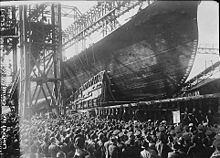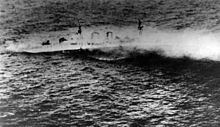Myōkō (ship, 1929)
|
Heavy cruiser Myōkō
|
||||||||||||||||||
|
||||||||||||||||||
|
||||||||||||||||||
|
||||||||||||||||||
|
||||||||||||||||||
The Myōkō ( Japanese 妙 高 ) was a Japanese heavy cruiser and type ship of the Myōkō class . It was used by the Imperial Japanese Navy in the Pacific War. The ship was named after the mountain Myōkō , a volcano near the city of the same name Myōkō . The ship was sunk in July 1946 after the Second World War .
Construction and modernizations
The keel laying of the Myōkō took place on October 25, 1924 at the Yokosuka naval shipyard . After the end of its construction period and completion of the equipment, it was put into service on July 31, 1929.
The cruiser Myōkō has been modernized and upgraded several times in order to be able to counter the growing threat of air strikes. In June 1943, for example, he received four additional 25 mm twin automatic cannons and a Type 21 radar to search for aerial targets. In November 1943, the anti-aircraft armament was again increased by eight individual 25 mm automatic cannons.
Calls
China
During the Second Sino-Japanese War in May 1938, Japanese forces attempted to take control of Amoy Island . Japanese Marines landed on the island on May 10 and overran the 75th Division of the National Chinese . The Myōkō , as part of the 5th Fleet, secured the landing section and provided fire support for the Japanese attack by bombing enemy positions.
When Japanese units occupied Hainan in February 1939 , the Myōkō took part in the operation as the flagship of Vice Admiral Kondō .
Philippines and Java
On December 4, 1941, the Japanese occupation of the Philippines began ; on December 6, the Myōkō left as the flagship of the 5th cruiser division under Rear Admiral Takagi Palau to support Japanese troops in the invasion of Legaspi and Davao . The landings were carried out on December 11th and December 19th and supported as planned by the 5th Cruiser Division. On January 4, 1942, B-17 bombers attacked the fleet at Davao and scored a bomb hit on the Myōkō . The cluster bomb hit the forecastle level with tower "B", caused severe damage to the deck, killed more than 20 sailors and wounded around 40 others. The ship had to return to Sasebo to have repairs carried out by February 20.
The Myōkō returned to the fleet and took part in the Battle of the Java Sea . On March 1, 1942, a Japanese fleet around the heavy cruisers Nachi , Haguro and Myōkō , who accompanied a convoy of Japanese transport ships, caught a mixed allied task force led by the heavy cruiser Exeter .
In the following battle, the Myōkō was involved in the destruction of the Exeter . After heavy hits by the Japanese cruisers, the British ship lost all propulsion power and finally sank after a torpedo hit by a Japanese destroyer .
In early April 1942, the Myōkō returned to Japan and was involved for a few days in the unsuccessful search for Halsey's fleet , whose planes had attacked Tokyo on April 18 .
In May 1942 she was part of the security association that was supposed to support the Japanese landing in Port Moresby . After the operation was canceled, she returned to Japan.
Midway and Guadalcanal
During the Japanese attempt to conquer the Midway Islands , the Myōkō belonged to the support group, again under the command of Vice Admiral Kondō . The fleet had no enemy contact during the Battle of Midway .
After an operation against Attu and Kiska , she was transferred to Truk in August 1942 . At the end of January 1943, after the Battle of Guadalcanal, she was involved in the evacuation of Japanese troops from the island.
In May 1943 she was involved in another evacuation and secured the evacuation of the Japanese bases on Attu and Kiska .
Until the end of 1943, their main task was transport missions and convoy security tasks between Japan and the bases on Rabaul and Truk. It survived the attempt to prevent the American landing near Bougainville and the American air raid on Rabaul on November 2, 1943 undamaged.
After a stay in a shipyard in Japan, the Myōkō was sent to Tarakan on Borneo in May 1944 to refuel there near the oil fields.
She took part as an escort in the battle of the Philippine Sea in June 1944 . After heavy losses among the Japanese carrier aircraft, the operation was finally canceled.
Battle of Leyte and the end
In October 1944, the Myōkō was part of the Japanese naval units that were supposed to thwart the American attempt at landing in the Philippines .
As part of the Japanese main force, it ran from Brunei through the Palawan Strait into the Sibuyan Sea . While two heavy cruisers from their fleet - Maya and Atago - were sunk in the Palawan Passage by US submarines, the Myōkō continued on its way with the fleet and finally came under the air attack of American carrier aircraft during the battle of the Sibuyan Sea . While the mass of American carrier aircraft pounced on the battered super battleship Musashi , the Myōkō was hit by a single torpedo at the stern, which made two propellers unusable. The Myōkō was then released from the association. She ran back for emergency repairs, but had to be relocated to Singapore , where suitable shipyard facilities were available for work on the underwater hull.
After a stay in Singapore, she was marched towards Cam Ranh Bay , but hit and badly damaged on the way on December 13 by a torpedo from the US submarine Bergall .
So she returned to Singapore and was no longer able to enter the harbor on her own.
After an examination of the damage, the ship was classified as “irreparable”. Due to the war situation, relocation to Japan was also impossible, so it was decided to use the ship as a floating anti-aircraft platform. The cruiser was camouflaged and moored next to the Takao, which was also damaged .
To neutralize the threat posed by the two cruisers' heavy ship guns, the Royal Navy carried out a commando operation against them. During the operation with the code name "Struggle", small submarines of the XE-Craft type penetrated the port on July 26, 1945 and tried to sink the two ships using explosive charges. The Myōkō survived the attack unscathed and was formally handed over to the surrender of the base on September 21.
The ship was towed from the port into the Strait of Malacca and sunk there in July 1946.
wreck
So far, no attempts have been made to track down the wreck of the Myōkō .
Evidence and references
Remarks
- ↑ around 1940 according to Japanese Cruisers of the Pacific War. P. 812 - Construction dates before modernization are described in the class article.
literature
- Eric LaCroix, Linton Wells: Japanese Cruisers of the Pacific War. US Naval Institute Press, 1997, ISBN 0-87021-311-3 .
Web links
Individual evidence
- ↑ Tameichi Hara: Japanese destroyer captain. US Naval Institute Press, ISBN 978-1-59114-354-3 , p. 53.



